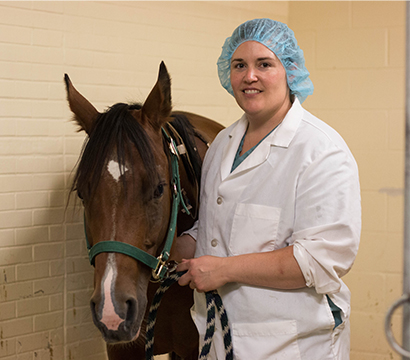
New role pins Thomas to WCVM
Her surgical residency as the Townsend Equine Health Research Fund (TEHRF) fellow has wrapped up, but Dr. Keri Thomas is staying put — and she couldn't be happier about it.
By Caitlin TaylorDuring the last four years, Thomas has learned from large animal surgeons at the Western College of Veterinary Medicine (WCVM) while also navigating her own clinical and research work. Now she's making the switch from surgical resident to an assistant professor at the college.
"I like working with groups of people that are specialists in their field. All of this information is right at your fingertips," says Thomas, who is covering a one-year sabbatical leave.
Thomas grew up on a North Dakota ranch before moving to Iowa State University to earn her veterinary medicine degree. She then spent a year as a clinical intern in Arizona before applying for a residency at WCVM.
"I came for an interview and fell in love with this place. The people here are a lot like the people at home," says Thomas, who is also working on a Master of Science degree in large animal surgery.
Her research, which was supervised by Drs. David Wilson and James Carmalt, focused on how best to heal fractures in horses' front legs.
When a fracture is unstable, casts alone are not always strong enough to support a horse's whole body weight. To help stabilize and distribute the animal's weight more evenly, surgeons often use a method called transfixation pin casting — drilling metal pins through the cannon bone and then attaching them to the cast.
"You drill a pin across the bone and you incorporate the pin in the cast, so the leg is just suspended within the cast," says Thomas.
She investigated two common methods: using two bigger pins or four smaller pins. Surgeons use both methods, but no one has ever compared them.
After orthopedic surgery, a horse with a fractured leg typically needs about six weeks of stall rest while wearing a cast — depending on the type of fracture. Even though it's confined, the horse still bears weight on its injured leg as it stands and walks around the stall.
Thomas and her supervisors worked with U of S College of Engineering researchers to design a project that simulated the pressure placed on the orthopedic pins during recovery.
Using 30 limbs from equine cadavers, researchers placed strain gauges — small sensors — in various spots along each leg to monitor pressure. Each strain gauge took digital measurements every one to two seconds over 23 hours.
With the help of James Johnston, an associate professor of mechanical engineering, Thomas interpreted the project's data. Results showed that the four-pin method was the most effective, but Thomas says further research is needed.
"The information also suggests that we need to think about a different design, maybe using three pins that are not as big as the two-pin model — but not as small as the four-pin model."
During her residency, Thomas also helped other WCVM colleagues with their own projects.
"When you're inexperienced, anything you can get involved in is very helpful. It gives you different perspectives," says Thomas, who looks forward to sharing her skills and experiences with students.
"What I've experienced here is going to be very helpful in my career. I don't have a lot of classroom teaching experience so the next year is going to give me that opportunity."
